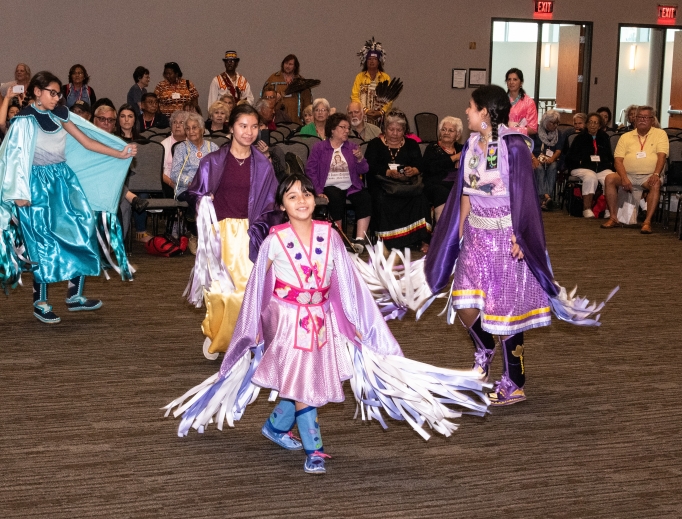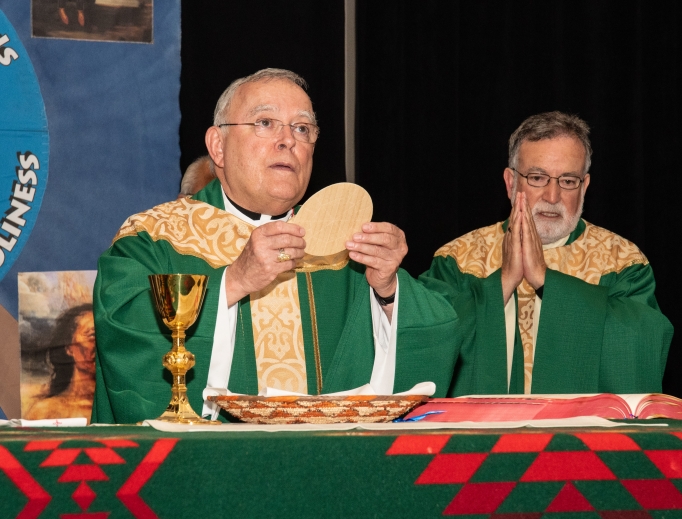Unveiling Potential Saints for the Americas
US Catholics are discovering a hidden but glorious legacy of holy lives and martyrs in North America thanks to the Tekakwitha Conference.

The seven years following St. Kateri Tekakwitha’s canonization in 2012 has started to unveil a powerful legacy of holy Catholic witness — even hundreds of martyrs — across North America from Native Catholic men and women.
New canonization causes are starting, and the Tekakwitha Conference, which just celebrated its 80th anniversary, is playing a critical role in reintegrating Catholics with this heritage of holiness in the Americas.
“The blueprint for sainthood, as exemplified among each of these, and, indeed, every saint, is their complete and total abandonment to Jesus Christ,” explained Robert Barbry II, executive director of the Tekakwitha Conference.
“These Native American saints and prospective saints shine a light on the free choice they made to follow Christ, no matter the cost,” he said.
Two of the leading causes today involving Native Catholic holiness are Servant of God Nicholas Black Elk and the group known as the Martyrs of La Florida, which includes hundreds of Native Catholic men, women and children martyred for the Catholic faith at the direction of English Protestants.
The story of Black Elk, or Heȟáka Sápa, (c.1863-1950) has been told partly through Black Elk Speaks, a biographical account that covered his youthful days as a Lakota holy man up to the Wounded Knee massacre.
Black Elk became Catholic in 1904, becoming a Catholic catechist known among the Jesuits as a “second St. Paul” and a “fervent apostle” for his evangelization among the Lakota. Black Elk lived his Catholic faith fully through the Lakota tradition and brought 400 Lakota into faith in Jesus Christ by the time he died.
William White, a Lakota Catholic in formation for the diaconate, and the diocesan postulator for Black Elk’s cause for the Diocese of Rapid City, South Dakota, presented the latest developments on Black Elk’s cause at the Tekakwitha Conference, which convened this year July 17-21 in Sharonville, Ohio.


Black Elk’s cause began in earnest after a petition with 1,600 signatures for his cause was submitted to the Diocese of Rapid City in 2016. The cause formally opened the following year, and it gained the unanimous approval of the U.S. bishops at their assembly in November 2018. The diocesan phase concluded on June 25.
“Our positio is now in Rome,” White told the Register. Now that Black Elk’s cause is in the Roman phase, White said the diocesan team for Black Elk’s cause will be working on how to promote the cause more widely in the U.S. White said they will work to set up a dedicated website. They are also considering putting earth from Black Elk’s grave into small containers as relics.
Now they literally need a miracle — one is needed for beatification, and two are necessary for canonization. White said he has heard of healings due to Black Elk’s intercession, but documentation is needed to show the healing was beyond science to explain and that the person was not asking other saints or the Virgin Mary for their intercession.
“They can only be praying to Servant of God Nicholas Black Elk,” he said.
White explained that Black Elk shows Catholics today — particularly those struggling with the scandals in the Church today — that their faith does not depend on fallen human beings in the Church. White explained Black Elk’s Catholic faith was not deterred by his negative experiences with Euro-Americans because his faith rested completely in Jesus Christ, his Creator and Savior.
“I think the Church really needs that now,” he said. “Are you going to give up your Savior because of human weakness? Were they your Savior, or is Jesus?”
More Catholic Heroes Emerge
Black Elk’s cause is generating more excitement and interest in other potential causes of holiness.
Preceding Black Elk by nearly 300 years is the Wendat (Huron) Catholic evangelist and proto-martyr Joseph Chiwatenhwa (1602-1640). Chiwatenhwa worked closely with St. Jean de Brebeuf and the French Jesuit missionaries (later martyrs) and was praised by contemporaries as the “Apostle with the Apostles.”
Chiwatenhwa and his wife, Marie Aonetta, were singled out for praise by St. John Paul II in a 1984 address to the First Nations gathered at Martyrs’ Shrine in Midlands, Ontario, on the importance of Indigenous Catholic witness, culture and traditions to the Church and the whole world. The Holy Father praised the “heroic manner” in which Chiwatenhwa and Aonetta lived the Catholic faith, adding that they “provide even today [for the Church] eloquent models for lay ministry.”
Father Myles Gaffney, a St. Kateri scholar and the Diocese of Calgary’s vicar for indigenous affairs, presented an address on Joseph Chiwatenhwa at this year’s Tekakwitha Conference. While Catholics know a lot about St. Kateri thanks to biographies by her Jesuit mentors, Father Gaffney said the Jesuits wrote about no one as much as Chiwatenhwa in The Jesuit Relations, which provide accounts of the Jesuit missionaries in the indigenous nations around New France.
“His virtue is the same stature as Kateri, or in the same ballpark,” Father Gaffney said. Whereas St. Kateri was deeply engaged in the contemplative life, Chiwatenhwa was more engaged in the active life. He delivered “fearless speeches,” calling on the Wendat people to embrace faith in Jesus Christ as the fulfillment of their belief in the Creator, and ventured into present-day western New York to aid the Wenro refugees fleeing the advance of the Five Nations of the Haudenosaunee (Iroquois Confederacy). He completed the Spiritual Exercises of St. Ignatius and composed a mystical poem about life in Jesus shortly before his death, which he anticipated (elsewhere in The Jesuit Relations) would be on account of his Catholic witness among his people. Father Gaffney explained that Chiwatenhwa’s death was at first blamed on the Wendat’s enemies, but later testimony and facts indicated that Chiwatenhwa died a martyr, as he predicted.
Father Gaffney said less is known about Aonetta, but her own faith in God leaps off the page in The Jesuit Relations, such as her exhortation to her family that they should all become saints. If Aonetta and Chiwatenhwa were made a joint cause, Father Gaffney agreed they could very much be patron saints and lay models for the New Evangelization.
“I can’t think of a better time for this canonization cause than now,” he said.
Pablo Tac: Holy Luiseno Youth
In the course of writing a book on St. Junípero Serra, Christian Clifford, Catholic author and part-time faculty member at St. Patrick’s Seminary in Menlo Park, California, discovered the writings of a holy youth, Pablo Tac.
“I started reading them and was blown away,” he told the Register.
Clifford presented on Tac at the Tekakwitha Conference, showing Tac as a holy Catholic youth from California that should be recognized by the universal Church. Tac was a Luiseno scholar, who wrote down the Luiseno people’s language, customs and norms, and attended Urban College in Rome. He was on his way to become the first Luiseno priest for the newly created Diocese of California until his untimely death in 1841.
“I think we have a great example of a holy young person to share with the Church,” Clifford said, adding he has been deeply moved by Tac’s own faith and perseverance in the face of adversity.
Clifford said the mission system in California did have disastrous unintended consequences for Native Californians owing to high death rates from European-introduced diseases. The one mission that succeeded in overcoming those odds for a time was Mission San Luis Rey, where Tac was baptized in 1822. But Clifford said there were also “really beautiful things here with the natives who did convert,” and Pablo Tac is part of that “powerful, fuller picture” that is emerging about native California Catholic holiness.
Clifford has written a new book about Tac and said he reached out to Luiseno leaders, as well as the Franciscans and the Diocese of San Diego, about getting a cause started for the Luiseno Catholic youth. Clifford said he was inspired by Black Elk’s cause in May to create the online petition, which has approximately 150 signatures in addition to another 100 he has collected.
“It’s really in its infancy right now,” he said of his effort.
Crown Jewel: The Martyrs of La Florida
However, the cause for the Martyrs of La Florida could reshape how Catholics in the U.S. understand their story and appreciate how deeply the Catholic faith was planted in U.S. soil.
Dr. Mary Soha, vice postulator for the cause and former member of the Commission for the Canonization of Kateri Tekakwitha, presented on the martyrs at this year’s Tekakwitha Conference. She told the Register that the cause is still in the diocesan phase, and they keep discovering new documentation that has so far added 400 names to the cause, which is led by Apalachee Antonio Cuipa, who was killed in a raid by British colonists.
“We’re getting more and more names and witness accounts,” Soha said. Most of the members of the cause are lay Catholic men and women who belonged to Native American nations allied with Spain and were targeted for extermination by English Protestants in the early 18th century, who offered to spare their lives if they would abandon their Catholic faith and go into slavery. Among these men and women are scores of Catholic missionaries and even Spanish-Americans born in La Florida, an area that encompasses both the present-day state of Florida, as well as parts of present-day Southeast U.S., including Alabama and Georgia. Some of the people in the cause met their deaths in Virginia’s Chesapeake Bay area.
Soha said La Florida history is vital for Catholicism in the U.S. because these missions are one example in the Americas where native peoples would come to embrace the Catholic faith without coercion. Soha said the missionaries in the La Florida missions carried out their ministry without the backing of Spanish soldiers or colonial entanglements — a situation the California missions were not allowed to imitate a century later. (The Spanish monarchs, Soha explained, had excluded the area of La Florida from colonialization and direct military control and deliberately left the caciques of native nations allied with Spain in charge of their own territory and affairs). Soha said present-day Catholic catechists and evangelists can learn from these martyrs how to “reintroduce Jesus Christ to America.”
“These martyrs demonstrate the quality of evangelization that was done,” she said. “All these martyrs had the opportunity to deny their faith and live.”
Every potential cause presented each year at the Tekakwitha Conference — such as the Holy Martyrs of Kahnawake (the 17th-century Haudenosaunee “praying village” that St. Kateri joined and is present-day Mohawk territory in Canada) or the incorrupt Rose Prince of the Dakelh in Northwest Canada — is both challenging commonly accepted narratives about the Church’s history and laying down a powerful challenge for lay Catholics today to take up the call of holiness in even the darkest of times, according to experts.
The Tekakwitha Conference’s Barbry \these heroic native Catholic men and women show the way forward through a current time of great trial for laity and clergy.
“We can look to the stories of these native saints and learn that humility and charity are the lights along the path to healing,” he said, “and, ultimately, holiness.”
Peter Jesserer Smith is a Register staff writer.
- Keywords:
- black elk
- martyrs of la florida
- native american saints
- native americans
- peter jesserer smith
- st. kateri tekakwitha
- tekakwitha conference

















